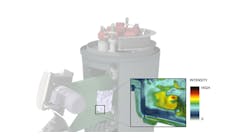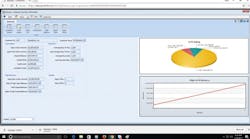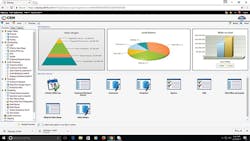When the acronym CRM (Customer Relationship Management) is mentioned, inevitably people think of a sales and marketing tool. While this is true, a good CRM system will also present a 360-degree view of the customer relationship. What is a 360 view? Many times companies view their customer relationships through their own lens, through their own window. A good CRM system will allow you to view the customer relationship through a broader perspective that includes the customer’s view. And this view is a critical asset to any business’ long-term success.
For example: Employees complain that Customer “A” is a royal pain; Customer “A” never pays and is always demanding attention. But, a good CRM system will show your On-Time Delivery is only 60% … That scrap is 18%, and rising … That quotes are taking 60 days to complete … and the customer’s concerns and complaints are never followed up. No wonder Customer “A” is a pain!
There are numerous benefits to a CRM system, some of which are financial; Nucleus Research reports that CRM use generates $8.71 in revenue for every $1 spent. Other benefits may be seen in improved process efficiency. The focus of this piece is the growth opportunities and benefits of managing customer relationships and tracking opportunities.
Managing customer relationships — A common business adage is that it costs five times more to attract a new customer than it does to keep an existing customer. Many companies have proven the truth of this, as the first rule of any business is to retain customers by building a loyal relationship with them and minimizing customer acquisition costs.
However, not enough companies view their customer relationships from the customer’s perspective. This is the reason for lost jobs, lost opportunities, and customer churn. Continually replacing a “low cost” customer with a “high cost” new customer creates a very challenging business environment.
To avoid operating in such an environment, Customer Service, Management, Sales, Production, your entire company, must be on the same page, having access to the same information.
What types of information? At the very least, that information should include: Quality, On Time Delivery Performance, Collections, Open ARs, and Activities with Follow-Ups from other departments. While most businesses track this data at some level, too often the information is not compiled but stored in fragments across the organization, with only weekly meetings, emails or frantic phone calls to collect these details — which, of course, are critical to business success. Obviously, this is an inefficient way to support customers, the lifeblood of any business.
All in One View
Imagine being a customer and having to wait a few hours or even days to receive the information you need now. By having all the information in one, easy-to-view setting, businesses set the proper responsive tone with their customers and, most important, differentiate their brand from competitors. If a business does not use service and support to differentiate itself from other companies, all that is left to differentiate it is price.
Tracking opportunities and sales pipeline — New sales are great, but converting a prospect into a customer can be a daunting process and may cause problems with the rest of the organization and beyond. As most sales professionals know, sales are never linear — they zigzag. A properly executed Sales Pipeline takes out some of the zig from the zag and allows an organization to track and manage opportunities better. A properly designed Sales Pipeline also gives the Sales Department the ability to understand better which opportunity may be close to signing, and which are the “tire kickers.” This allows Sales to use their time resources better.
Too often, Sales people spend more time trying to convince the tire kickers than closing viable business. A properly staged pipeline reduces distractions and ensures Sales is focused on the correct opportunities. The basis of a properly designed and executed Sales Pipeline is information, the kind of information a CRM provides.
A very good way to stress your company and your current customer relationships are “unexpected sales”: a new job or prospect that comes aboard with little or no notice to other departments (Engineering, Manufacturing, etc.) that will be involved in servicing the account. When that opportunity arrives, everyone in the company starts scrambling to catch up to it. Another problem appears when Sales, Engineering and Production are not coordinated from the start of the unexpected sales project.
For example: Sales may have promised that the first casting will ship within 12 weeks, but the plant is scheduled out 14 weeks. Then, the organization may not have all the necessary materials and expertise for the unexpected job, and now the whole team has to scramble to make this happen, placing current customer jobs at risk.
A well-managed, properly staged Sales Pipeline will eliminate surprises and significantly smooth the customer’s transition from quote to casting.
So, what is a properly staged Sales Pipeline? Every sales organization goes through some common stages to close on a sale. To understand and mange those stages, review recent opportunities (both wins and losses) with your Sales team, and look for similarities. The pattern is there; you need to find it.
For example, one simple sequence for a properly staged Sales Pipeline might include: Initial Contact; Meeting; Blueprint Submission; Question; and “Ask for Business.”
As each stage is completed, the opportunity will move from step to step so that when the prospect finally arrives at the “Ask for Business” stage, the team knows they have an 90%+ chance of closing the sale, giving Engineering and Manufacturing the signal to start prepping for the job. It is a good business practice to start with a few stages and work gradually into a more complete staging system.
Thorough integration — When implementing a CRM system, one critical objective is to ensure the CRM is integrated throughout the ERP system, to keep all the organization’s departments on the same page with critical business information. When a Correction Action is created for a part, this should update the CRM system. When orders are entered, shipped, or invoiced, all of these details should update the CRM system in real-time. Entering information once, for those responsible for that information, is a tremendous benefit to customers, employees and any company’s bottom-line.
Also, a good CRM system must be cloud-based and accessible from any device with an Internet connection (of course, assuming the correct security is in place.) This ensures CRM benefits are not limited to the office and can be accessed as needed in today’s mobile world.
Customer relationships are a critical factor determining why a customer buys from a business, your business. Such relationships are comprised of myriad individual actions (responses, on-time delivery, quality, etc.) that build into the customer’s perception of your business and their relationship with your business. Providing access to actionable insights to the relationship customers have with your business is the fundamental reason that Customer Relationship Management software exists — and how manufacturers benefit from CRM.
Matt Gacek is Vice President - Business Development for B&L Information Systems. Contact him at [email protected], or visit www.blinfo.com










